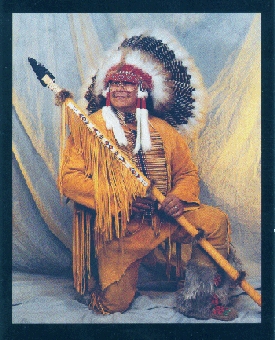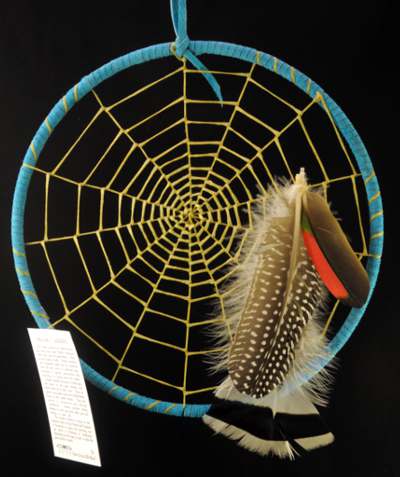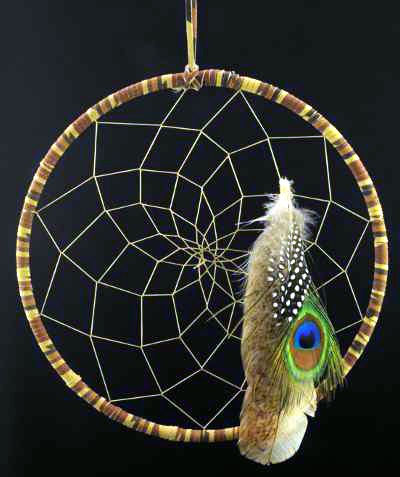DreamCatcher.com Artist Profile
Sometimes it takes a life changing experience to bring us back to what should have been changed to begin with.
 Tom Gray Elk Rail is a native Denverite. Raised Hispanic and growing
up speaking Spanish and English, it took a near death experience to
bring him back to his American Indian roots. Today, Rael is affiliated
with the Picuris Pueblo, "People of the Hidden Valley," and
is an artist, flute player and story teller. He creates three-dimensional
native American artwork withich utilizes the "energetic gifts"
of the birds and animals.
Tom Gray Elk Rail is a native Denverite. Raised Hispanic and growing
up speaking Spanish and English, it took a near death experience to
bring him back to his American Indian roots. Today, Rael is affiliated
with the Picuris Pueblo, "People of the Hidden Valley," and
is an artist, flute player and story teller. He creates three-dimensional
native American artwork withich utilizes the "energetic gifts"
of the birds and animals.  He is most well known for his dream catchers,
fans and prayer feathers.
He is most well known for his dream catchers,
fans and prayer feathers.
Born and raised in Denver, Rael is a 1969 graduate of North High School. He graduated from the Engineering and drafting School of Denver in 1972 and was a cement contractor until 1987 when he and a group of four hunters including Rael thought he had successfully shot a bull elk, but as he neared the collapsed beast, it rose to full height and targeted Rael with its anger. He was hospitalized, told he might never walk again and opted for physical therapy rather than back surgery.
Rael had to give up his work as a contractor because of his new physical limitations and came home from the hospital in a wheelchair. Whil lying in bed one afternoon, he was called by a stranger who asked directions to his home. The person identified himself as Native American Indian medicine man and arrived at Rael's home about two hours later carrying a bundle of herbs. He told Rael, "If you want to walk again then you must walk the path of your people." It was enough to make Rael start asking questions of his parents and later his grandfather, Juan Rael. His grandfather, who spoke five Indian languages as well as Spanish and English disclosed a family secret which had been hidden for three generations: the family was Indian-descendants of a Spaniard named Juan de Jesus Rael and the Picuris woman he married in 1754.
Rael learned that both his parents are American-Indians from New Mexico. His father's family came from Picuris Pueblo and his mother's from what is now called the Jicarilla Apache Indian Reservation. The couple had left New Mexico and their American Indian heritage behind. It was 1946 when his father arrived in Denver with the hope of escaping the prejudice experienced as an American-Indian. He had been advised to live as an Hispanic one.
Armed with the answers to his questions, Rael now understood the medicine
man's words of wisdom. He began to walk what he calls a "spiritual
path," exploring his heritage and native roots with tribal elders.
The elders at Picuris gave him the name "Gray Elk" in remembrance
of the elk in the forest. As his understanding grew, so did his ability
to walk and he assumed a deeper understanding of the American-Indian
ways. It was in 1988 when Sioux elders took Rael on a Vision Quest.
This was a many-day-long journey during which Rael was taught to make
the Lakota-style dream catcher.
roots with tribal elders.
The elders at Picuris gave him the name "Gray Elk" in remembrance
of the elk in the forest. As his understanding grew, so did his ability
to walk and he assumed a deeper understanding of the American-Indian
ways. It was in 1988 when Sioux elders took Rael on a Vision Quest.
This was a many-day-long journey during which Rael was taught to make
the Lakota-style dream catcher.
Curiously, many of Rael's activities since childhood had connected
him to his hidden American-Indian roots. He raised birds beginning at
age six, birds which were through tradition connected to his roots. Today, Rael and his wife, a psychologist, maintain a 162
acre ranch near Brighton, Colorado where they raise a variety of birds
and miniature horses. Rael uses only feathers from live domestic birds
in his artwork, with each feather having a specific meaning depending
on the type of bird. many of these feathers are used to create the Sioux-style
dream catchers, round hoops that are webbed with a sinew-like material
according to an ancient legend about the spider. Rael weaves the web
of the dream catcher backward so as to turn back time in the dream-world
of spirit and gives the dreamer a better night's sleep. "You sleep
because your physical self needs the rest," says Rael. "Your
spirit doesn't sleep. Whatever the spirit finds as it wanders in the
dream time it brings back in your sleep in the form of good dreams or
bad." Native American legend teaches  that by having a dream catcher
in the bedroom, only good dreams float around the sleeper. The feathers
Rael places on the dream catchers will have a particular meaning to
help the dreamer find what they are seeking in their life. Traditionally,
a dream catcher is hung on an infant's cradleboard, often with a feather
attached to bring good health.
that by having a dream catcher
in the bedroom, only good dreams float around the sleeper. The feathers
Rael places on the dream catchers will have a particular meaning to
help the dreamer find what they are seeking in their life. Traditionally,
a dream catcher is hung on an infant's cradleboard, often with a feather
attached to bring good health.
The Dream Catcher parallels elements of so many indigenous people's
cultures, explains Rael. Where the Dream Catcher is positioned is as
important as how one sleeps, head to north, feet to the south. These
are among the traditions that Rael, as a devotee to the American-Indian
ways is so willing to share with those eager to listen, "What I've learned, I need to pass along,"
says Rael. "Every day that we bury an Elder, we bury a large piece
of our history. Now that I 've learned my history, I am eager to share
it."
(Article by Nancy Clark of Emerging Markets magazine)